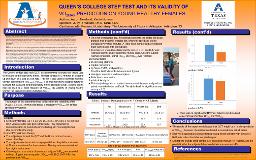
ATTENTION: The works hosted here are being migrated to a new repository that will consolidate resources, improve discoverability, and better show UTA's research impact on the global community. We will update authors as the migration progresses. Please see MavMatrix for more information.
Show simple item record
| dc.contributor.author | Newland, Aaron | |
| dc.contributor.author | Nguyen, Kevin | |
| dc.date.accessioned | 2019-04-10T00:02:52Z | |
| dc.date.available | 2019-04-10T00:02:52Z | |
| dc.date.issued | 2018-12 | |
| dc.identifier.uri | http://hdl.handle.net/10106/27945 | |
| dc.description | KINE 4400 | |
| dc.description.abstract | **Please note that the full text is embargoed** ABSTRACT: INTRODUCTION: The Queen's college step test (QCT) is a submaximal exercise test that is used to measure cardiorespiratory fitness. The test consists of 3 minutes of stepping up and down on a 15-inch step at a set rate of 22 steps/min. This test can also be used to estimate maximal oxygen consumption (VO2max). VO2max is an internationally accepted reference standard for assessing cardiorespiratory fitness (Shepard 1968). A lower maximal oxygen capacity is a strong predictor of cardiovascular disease. Despite claims that the QCT is a valid measure of VO2max, its validity in young healthy women has been contested (Chatterjee 2003). This study was conducted to determine the applicability of the QCT in young healthy women in predicting VO2max. Variables measured during this study are heart rate (HR), rate of perceived exertion
(RPE), and VO2max .
PURPOSE: The purpose of this experiment was to determine the reliability of the Queen’s College 3-minute step test as a predictor of VO2max for college aged healthy women.
METHODS: Six women (W; age; 19.7 ± 1.6 yrs) of the UTA student population volunteered to participate in this study. Each subject performed a QCT and a Bruce protocol graded exercise test on a treadmill on non-consecutive days. The Bruce protocol is a maximal exercise test where the speed and incline progressively increase at every stage (3 minutes) until the subject reaches fatigue. The subjects’ respective VO2max were compared between their step test and Bruce exercise. During the step test, resting heart rate
(RHR), resting blood pressure (BP), and the heart rate after the step test (HRstep) were recorded. As for the Bruce protocol, maximum oxygen consumption (VO2max), time to fatigue, blood pressure, rate of perceived exhaustion (RPE), and maximal heart rate (HRmax) were measured.
RESULTS: The values for the QCT were: RHR = 78.3 ± 5.5 bpm ; SBP = 109.7 ± 10.4 mmHg; DBP = 62.3 ± 5.43 mmHg; HRstep = 161.5 ± 11.6 bpm . The average predicted values of VO2max= 35.63 ± 2.2 ml/kg/min. The average predicted values of HRmax (220-age) = 200.3 ± 1.63 bpm. The maximal values for the Bruce protocol max test were: HRmax = 191.4 ± 3.91 bpm ; time to fatigue = 9.12 ± 0.74 mins ; RPE = 16.8 ± 1.10. The average measured VO2max= 31.54 ± 3.81 ml/kg/min. A two-tailed, repeated measures t-test was used to determine the difference between predicted VO2max and measured VO2max, which was not significant (p = 0.53). A two-tailed repeated measures t-test was used to determine the difference between predicted HRmax and measured HRmax, which was also not significant (p = 0.56).
CONCLUSION: The results of this study provide evidence towards the claim that the QCT might be a reliable predictor for VO2max, as well as HRmax. However, the equation used to approximate one’s VO2max tended to slightly, though not significantly, overestimate measured VO2max. | en_US |
| dc.description.sponsorship | Faculty Sponsor: Judy R. Wilson | en_US |
| dc.language.iso | en_US | en_US |
| dc.publisher | The University of Texas at Arlington | en_US |
| dc.subject | step test | en_US |
| dc.subject | Queen's college | en_US |
| dc.title | Queen's College Step Test and Its Validity of VO(2max) Prediction on Young Healthy Females | en_US |
| dc.type | Presentation | en_US |
| dc.publisher.department | Department of Kinesiology | |
Files in this item
- Name:
- NewlandNguyenPOSTER.pdf
- Size:
- 452.1Kb
- Format:
- PDF
- Description:
- PDF
This item appears in the following Collection(s)
Show simple item record


